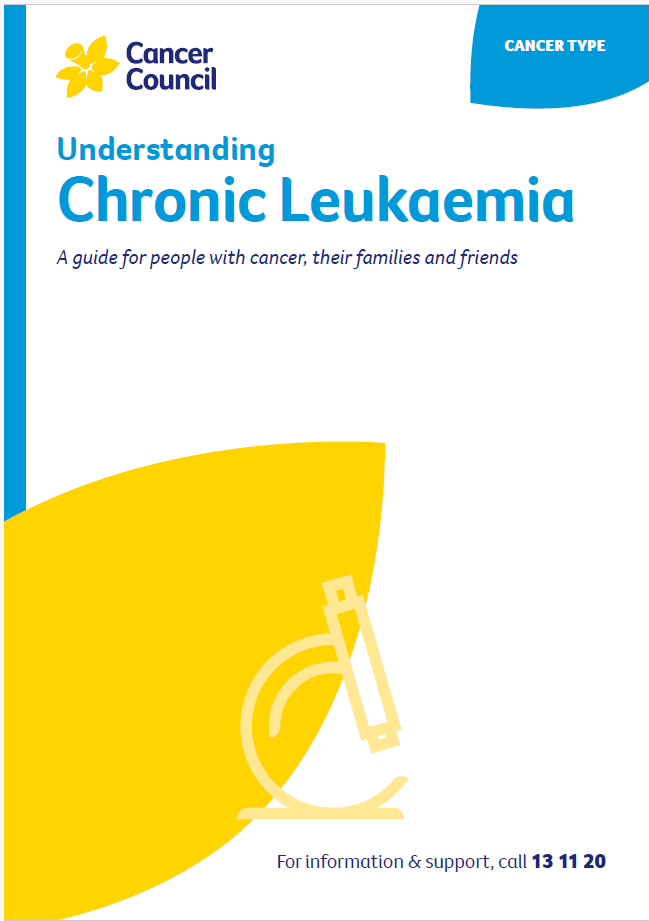- Home
- Chronic lymphocytic leukaemia (CLL)
- Treatment
Treatment for CLL
At first you might not need treatment if you have early-stage chronic lymphocytic leukaemia (CLL) and no symptoms. Some people never have treatment. If you need treatment, it usually includes targeted therapy, with or without immunotherapy (monoclonal antibodies). Chemotherapy is less commonly used.
For a small number of people (5–10%), CLL changes (transforms) into a type of non-Hodgkin lymphoma called diffuse large B-cell lymphoma. This is known as Richter’s transformation. Diffuse large B-cell lymphoma is a fast-growing type of lymphoma that usually needs to be treated straightaway. Your doctor will discuss the available treatments.
Learn more about:
- Active monitoring
- Treatment options
- Making treatment decisions
- Targeted therapy and immunotherapy
- Other treatments
- Palliative treatment
Active monitoring
Having regular check-ups and blood tests instead of treatment is called active monitoring, careful monitoring or watch and wait. For people with no symptoms, starting treatment immediately is no better than waiting until treatment is needed. Waiting means that you delay any side effects.
CLL can make you more likely to catch infections such as shingles, the flu and COVID-19. Learn the signs of infections to watch out for, and get treatment as soon as possible if they appear. You should not have the shingles vaccination as it contains a live virus, which can be dangerous to people with lowered immunity. You will also be advised to have regular skin checks, as people with CLL are more likely to develop skin cancer.
Living with untreated chronic leukaemia may make you feel anxious. It may help to talk to your medical team or contact the hospital social worker or psychologist for support. You can also speak to other people who have CLL.
Treatment options
Your doctor may recommend you begin active treatment for CLL if:
- you develop symptoms such as fevers, drenching night sweats or weight loss
- the number of red blood cells and platelets in your blood falls
- your lymph nodes become very swollen and/or put pressure on important internal structures, such as your neck or kidneys
- your spleen becomes enlarged
- the number of lymphocytes in your blood doubles in less than six months.
The treatment you are offered will depend on the features of the leukaemia, and your age and general health.
Treatment will aim to get the disease under control. This is known as first-line treatment. Although most people respond well to treatment, it’s likely that the disease will come back (relapse) in some people. They may have further treatment known as second-line treatment.
Sometimes CLL doesn’t respond to treatment but the disease remains stable. This is known as refractory or resistant CLL. Your specialist will talk to you about other treatments you can consider. You may also want to join a clinical trial.
→ READ MORE: Making treatment decisions for CLL
Podcast: Making Treatment Decisions
Listen to more episodes from our podcast for people affected by cancer
More resources
Dr Chun Kei Kris Ma, Clinical Haematologist, Western Sydney Local Health District (clinical update); Delphine Eggen, Consumer; Dr Robin Gasiorowski, Staff Specialist, Haematology, Concord Hospital; Karl A Jobburn, Haematology Clinical Nurse Consultant, Liverpool Hospital; Yvonne King, 13 11 20 Consultant, Cancer Council NSW; Heather Mackay, Clinical Nurse Consultant, Westmead Hospital; Jennifer Paton, Consumer.
View the Cancer Council NSW editorial policy.
View all publications or call 13 11 20 for free printed copies.

